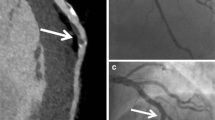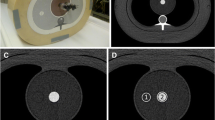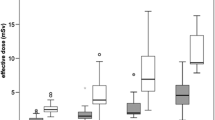Abstract
Objectives
To evaluate the image quality of coronary CT angiography (CCTA) in obese patients using a 3rd generation, dual-source CT scanner.
Methods
We retrospectively evaluated 102 overweight and obese patients who had undergone CCTA. Studies were performed with 3rd generation dual-source CT, prospectively ECG-triggered acquisition at 120 kV, and automated tube current modulation. Advanced modeled iterative reconstruction was used. Patients were divided into three BMI groups: 1)25–29.9 kg/m2; 2)30–39.9 kg/m2; 3) ≥ 40 kg/m2. Vascular attenuation in the coronary arteries was measured. Contrast-to-noise ratio (CNR) was calculated. Image quality was subjectively evaluated using five-point scales.
Results
Image quality was considered diagnostic in 97.6 % of examinations. CNR was consistently adequate in all groups but decreased for groups 2 and 3 in comparison to group 1 as well as for group 3 compared to group 2 (p = 0.001, respectively). Subjective image quality was significantly higher in group 1 compared to group 3 (attenuation proximal: 4.8 ± 0.4 vs. 4.4 ± 0.6, p = 0.011; attenuation distal: 4.5 ± 0.7 vs. 4.0 ± 0.8, p = 0.019; noise: 4.7 ± 0.6 vs. 3.8 ± 0.7, p < 0.001). The mean effective dose was 9.5 ± 3.9 mSv for group 1, 11.4 ± 4.7 mSv for group 2 and 14.0 ± 6.4 mSv for group 3.
Conclusion
Diagnostic image quality can be routinely obtained at CCTA in obese patients with 3rd generation DSCT at 120 kV.
Key Points
• Diagnostic CCTA can be routinely performed in obese patients with 3 rd generation DSCT.
• 120-kV tube voltage allows diagnostic image quality in patients with BMI > 40 kg/m 2.
• 80-ml contrast medium can be administered without significant decline in vascular attenuation.





Similar content being viewed by others
References
Budoff MJ, Achenbach S, Blumenthal RS et al (2006) Assessment of coronary artery disease by cardiac computed tomography: a scientific statement from the American Heart Association Committee on Cardiovascular Imaging and Intervention, Council on Cardiovascular Radiology and Intervention, and Committee on Cardiac Imaging, Council on Clinical Cardiology. Circulation 114:1761–1791
Stein PD, Beemath A, Kayali F, Skaf E, Sanchez J, Olson RE (2006) Multidetector computed tomography for the diagnosis of coronary artery disease: a systematic review. Am J Med 119:203–216
Stehli J, Fuchs TA, Bull S et al (2014) Accuracy of coronary CT angiography using a submillisievert fraction of radiation exposure: comparison with invasive coronary angiography. J Am Coll Cardiol 64:772–780
Raff GL, Gallagher MJ, O'Neill WW, Goldstein JA (2005) Diagnostic accuracy of noninvasive coronary angiography using 64-slice spiral computed tomography. J Am Coll Cardiol 46:552–557
Hou Y, Ma Y, Fan W et al (2014) Diagnostic accuracy of low-dose 256-slice multi-detector coronary CT angiography using iterative reconstruction in patients with suspected coronary artery disease. Eur Radiol 24:3–11
Brodoefel H, Tsiflikas I, Burgstahler C et al (2008) Cardiac dual-source computed tomography: effect of body mass index on image quality and diagnostic accuracy. Invest Radiol 43:712–718
Leschka S, Stinn B, Schmid F et al (2009) Dual source CT coronary angiography in severely obese patients: trading off temporal resolution and image noise. Invest Radiol 44:720–727
Ho JS, Barlow CE, Reinhardt DB, Wade WA, Cannaday JJ (2010) Effect of increasing body mass index on image quality and positive predictive value of 100-kV coronary computed tomographic angiography. Am J Cardiol 106:1182–1186
Tatsugami F, Husmann L, Herzog BA et al (2009) Evaluation of a body mass index-adapted protocol for low-dose 64-MDCT coronary angiography with prospective ECG triggering. AJR Am J Roentgenol 192:635–638
Sun G, Hou YB, Zhang B et al (2015) Application of low tube voltage coronary CT angiography with low-dose iodine contrast agent in patients with a BMI of 26–30 kg/m2. Clin Radiol 70:138–145
Wang R, Schoepf UJ, Wu R et al (2014) Diagnostic accuracy of coronary CT angiography: comparison of filtered back projection and iterative reconstruction with different strengths. J Comput Assist Tomogr 38:179–184
Alkadhi H, Scheffel H, Desbiolles L et al (2008) Dual-source computed tomography coronary angiography: influence of obesity, calcium load, and heart rate on diagnostic accuracy. Eur Heart J 29:766–776
Lee AM, Engel LC, Hui GC et al (2014) Coronary computed tomography angiography at 140 kV versus 120 kV: assessment of image quality and radiation exposure in overweight and moderately obese patients. Acta Radiol 55:554–562
Gordic S, Husarik DB, Desbiolles L, Leschka S, Frauenfelder T, Alkadhi H (2014) High-pitch coronary CT angiography with third generation dual-source CT: limits of heart rate. Int J Cardiovasc Imaging 30:1173–1179
Hell MM, Bittner D, Schuhbaeck A et al (2014) Prospectively ECG-triggered high-pitch coronary angiography with third-generation dual-source CT at 70 kVp tube voltage: feasibility, image quality, radiation dose, and effect of iterative reconstruction. J Cardiovasc Comput Tomogr 8:418–425
Gordic S, Desbiolles L, Stolzmann P et al (2014) Advanced modelled iterative reconstruction for abdominal CT: qualitative and quantitative evaluation. Clin Radiol 69:e497–e504
Moscariello A, Takx RA, Schoepf UJ et al (2011) Coronary CT angiography: image quality, diagnostic accuracy, and potential for radiation dose reduction using a novel iterative image reconstruction technique-comparison with traditional filtered back projection. Eur Radiol 21:2130–2138
Solomon J, Mileto A, Ramirez-Giraldo JC, Samei E (2015) Diagnostic performance of an advanced modeled iterative reconstruction algorithm for low-contrast detectability with a third-generation dual-source multidetector CT scanner: potential for radiation dose reduction in a multireader study. Radiology. doi:10.1148/radiol.15142005:142005
Wang R, Schoepf UJ, Wu R et al (2012) Image quality and radiation dose of low dose coronary CT angiography in obese patients: sinogram affirmed iterative reconstruction versus filtered back projection. Eur J Radiol 81:3141–3145
Utsunomiya D, Weigold WG, Weissman G, Taylor AJ (2012) Effect of hybrid iterative reconstruction technique on quantitative and qualitative image analysis at 256-slice prospective gating cardiac CT. Eur Radiol 22:1287–1294
Yuan R, Shuman WP, Earls JP et al (2012) Reduced iodine load at CT pulmonary angiography with dual-energy monochromatic imaging: comparison with standard CT pulmonary angiography--a prospective randomized trial. Radiology 262:290–297
Christner JA, Braun NN, Jacobsen MC, Carter RE, Kofler JM, McCollough CH (2012) Size-specific dose estimates for adult patients at CT of the torso. Radiology 265:841–847
Deak PD, Smal Y, Kalender WA (2010) Multisection CT protocols: sex- and age-specific conversion factors used to determine effective dose from dose-length product. Radiology 257:158–166
Boone JM SK, Cody DD, McCollough CH, McNitt-Gray MF, Toth TL (2011) Size-specific Dose Estimates (SSDE) in Pediatric and Adult Body CT Examinations. Report of Am Assoc Phys Med AAPM Task Group 204 2011. American Association of Physicists in Medicine, College Park
Bae KT (2010) Intravenous contrast medium administration and scan timing at CT: considerations and approaches. Radiology 256:32–61
Layritz C, Schmid J, Achenbach S et al (2014) Accuracy of prospectively ECG-triggered very low-dose coronary dual-source CT angiography using iterative reconstruction for the detection of coronary artery stenosis: comparison with invasive catheterization. Eur Heart J Cardiovasc Imaging 15:1238–1245
Geyer LL, Glenn GR, De Cecco CN et al (2015) CT evaluation of small-diameter coronary artery stents: effect of an integrated circuit detector with iterative reconstruction. Radiology. doi:10.1148/radiol.15140427:140427
Yin WH, Lu B, Li N et al (2013) Iterative reconstruction to preserve image quality and diagnostic accuracy at reduced radiation dose in coronary CT angiography: an intraindividual comparison. JACC Cardiovasc Imaging 6:1239–1249
Oda S, Weissman G, Vembar M, Weigold WG (2014) Iterative model reconstruction: improved image quality of low-tube-voltage prospective ECG-gated coronary CT angiography images at 256-slice CT. Eur J Radiol 83:1408–1415
Meinel FG, Canstein C, Schoepf UJ et al (2014) Image quality and radiation dose of low tube voltage 3rd generation dual-source coronary CT angiography in obese patients: a phantom study. Eur Radiol 24:1643–1650
Megyeri B, Christe A, Schindera ST et al (2015) Diagnostic confidence and image quality of CT pulmonary angiography at 100 kVp in overweight and obese patients. Clin Radiol 70:54–61
Acknowledgments
The scientific guarantor of this publication is U. Joseph Schoepf. The authors of this manuscript declare relationships with the following companies: Dr. Schoepf is a consultant for and receives research support from Bayer, Bracco, GE, Medrad, and Siemens. Mr. Canstein is a Siemens employee. The authors state that this work has not received any funding. One of the authors has significant statistical expertise. Institutional review board approval was obtained. Written informed consent was waived by the Institutional Review Board. Methodology: retrospective, observational, performed at one institution.
Author information
Authors and Affiliations
Corresponding author
Electronic supplementary material
Below is the link to the electronic supplementary material.
ESM 1
(DOCX 14 kb)
Rights and permissions
About this article
Cite this article
Mangold, S., Wichmann, J.L., Schoepf, U.J. et al. Coronary CT angiography in obese patients using 3rd generation dual-source CT: effect of body mass index on image quality. Eur Radiol 26, 2937–2946 (2016). https://doi.org/10.1007/s00330-015-4161-x
Received:
Revised:
Accepted:
Published:
Issue Date:
DOI: https://doi.org/10.1007/s00330-015-4161-x




